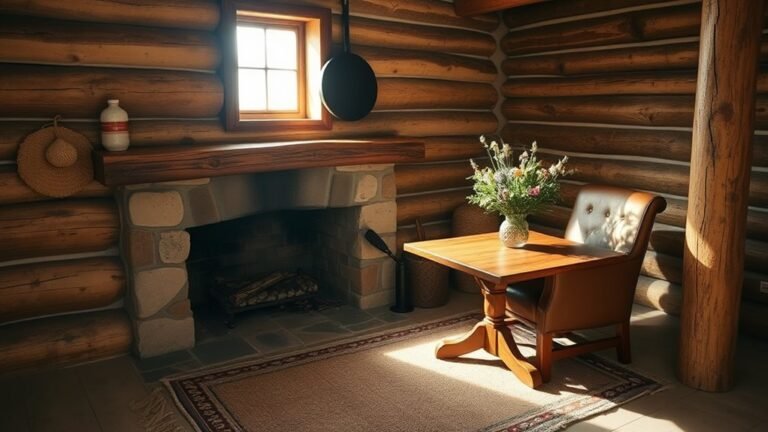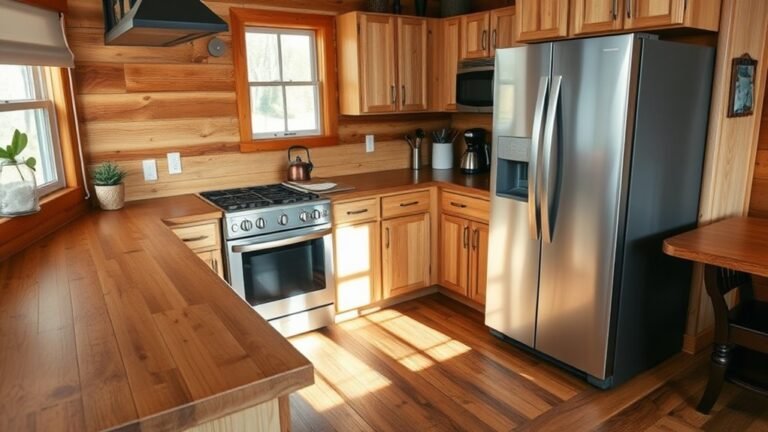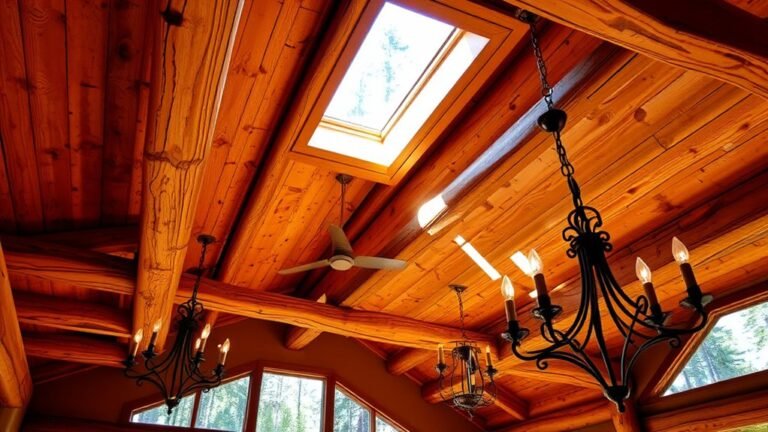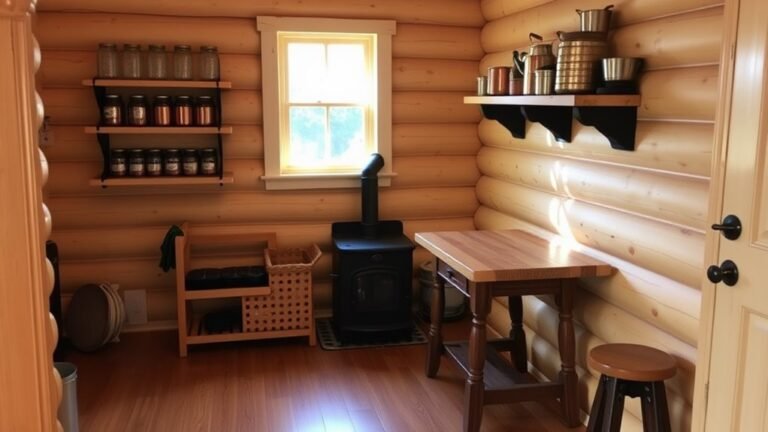16 Off-Grid Cabin Kitchen Ideas for Sustainable Living

Designing an off-grid cabin kitchen involves combining rustic charm with sustainability through natural materials and solar-powered appliances, creating an eco-friendly culinary space. Enhancements like rainwater harvesting and efficient ventilation can further elevate the kitchen’s functionality and environmental respect.
Additional features to consider for an enriched off-grid kitchen experience include energy-efficient lighting and composting solutions. These elements play crucial roles in achieving a sustainable living space that goes beyond basic needs.
Embrace Natural Materials

Design your off-grid cabin kitchen with natural materials for a warm, inviting atmosphere.
Use earthy tones of reclaimed wood and stone for rustic charm and a connection to nature. Wooden countertops and stone backsplashes can tell a story and evoke the outdoors. Incorporate weathered materials such as stone, wood, and brick to enhance the rustic aesthetics and create stunning visuals. Opt for natural textiles like linen or cotton for curtains to add coziness and light. Consider eco-friendly bamboo shelving for its sturdiness.
Add potted herbs or a small indoor garden for freshness and easy access to basil or rosemary for cooking.
Use Solar-Powered Appliances

For a sustainable off-grid kitchen, solar-powered appliances are key. Harness the sun to cook, store, and prepare food with minimal environmental impact.
Consider these solar-powered options:
- Solar ovens: Cook eco-friendly meals using only sunlight.
- Solar refrigerators: Keep food fresh without the grid.
- Solar water heaters: Use solar energy for warm dishwashing and cooking water.
- Solar-powered blenders: Make smoothies or soups using sunshine.
- Solar cookers: Experiment with recipes while utilizing solar energy.
Implement Rainwater Harvesting
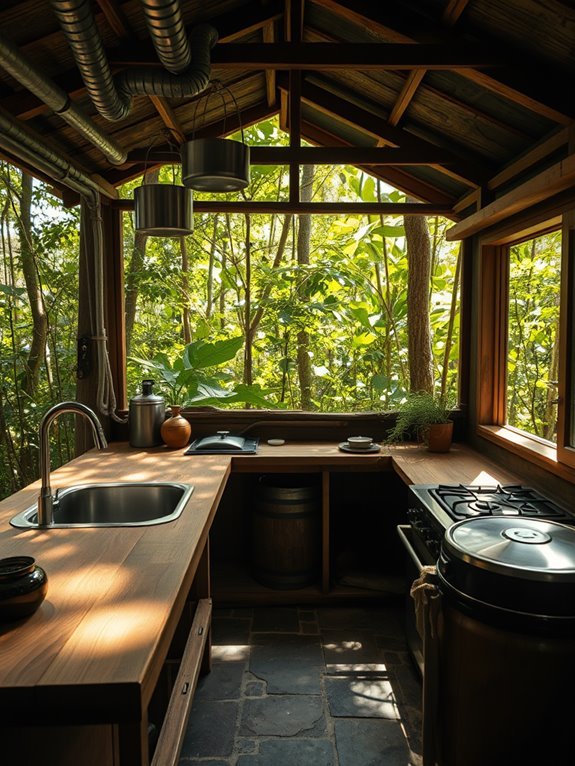
Rainwater harvesting is an effective way to boost your off-grid cabin kitchen’s sustainability by capturing rainwater from your roof for cooking, cleaning, and watering plants.
Start with a food-grade rain barrel or cistern and set up gutters to direct rainwater into them—it’s a simple DIY project.
Install a filtration system to ensure the water is clean and safe for use.
Regularly check and clean your system to maintain a reliable water source.
Embrace the rain and save money while living sustainably off the grid!
Design a Wood-Fired Stove

Designing a wood-fired stove for your off-grid cabin kitchen can be transformative, offering a reliable heat source and rustic charm that turns cooking into an adventure. Gather with loved ones as the aroma of a hearty meal fills the air. Benefits of a wood-fired stove include:
- Warmth and Comfort: Keeps your kitchen cozy during chilly nights.
- Energy Independence: Reduces reliance on electricity, supporting off-grid living.
- Flavor Enhancement: Imparts a smoky flavor that elevates your cooking.
- Sustainability: Eco-friendly, using locally sourced wood to lower your carbon footprint.
- Emergency Preparedness: A dependable cooking option during power outages.
With creativity and effort, design a stove that meets your needs and becomes your cabin’s centerpiece. Consider incorporating rustic decor elements to complement your wood-fired stove and enhance the overall aesthetic of your cabin kitchen. Gather your materials and craft your wood-fired masterpiece to cook with passion!
Create an Outdoor Cooking Area

An outdoor cooking area enhances your off-grid cabin experience, letting you enjoy nature while preparing meals. Picture making breakfast under the morning sun or grilling dinner beneath the stars. Choose a sturdy surface like a wooden or stone countertop for chopping and setting pots. Consider a fire pit or grill for smoky flavors, or even a wood-fired oven for pizzas. Expect friends drawn by the aromas through the trees. Include storage with a rustic shelf or crates for spices and utensils. String lights add ambience, creating a cozy spot for cooking and chatting. Natural materials such as wood and stone complement your outdoor setting, reflecting the serene beauty of nature. With creativity, your outdoor cooking area becomes the cabin’s heart. Grab your apron and prepare unforgettable meals, but watch out for squirrels—they love a good feast too!
Optimize for Space Efficiency

Maximize your off-grid cabin kitchen by optimizing space with clever layouts and creativity. Use floating shelves for spices and utensils, and a magnetic strip for knives.
Consider these ideas:
- Multi-functional furniture: Use a table as both a prep station and dining area.
- Vertical storage: Hang pots and pans on the wall to save space and add charm.
- Compact appliances: Choose smaller gadget versions—every inch matters.
- Drawer dividers: Organize items for quick access.
- Hidden compartments: Opt for furniture with concealed storage for infrequently used items.
With imagination and effort, your small kitchen can become a functional, inviting space.
Incorporate Reclaimed Wood

Optimize your off-grid cabin kitchen by using reclaimed wood, which adds charm and is eco-friendly.
Old barn wood can make unique countertops or cabinets, each piece with its own story. Reclaimed wood is available at local lumber or salvage yards, perfect for adding rustic appeal while reducing landfill waste.
Open shelving with reclaimed planks offers stylish and accessible storage, enhancing the space’s openness and warmth.
Add playful accents like a quirky reclaimed wood spice rack or a fun sign made from salvaged materials to create an inviting atmosphere for cooking and enjoying sustainable living.
Install a Composting System

While designing your off-grid cabin kitchen, consider installing a composting system to boost sustainability. It reduces waste and creates nutrient-rich soil for your garden. Imagine turning scraps into something beneficial!
Here’s why a composting system is essential:
- Reduce landfill waste: Keep organic matter out of dumps.
- Nourish your garden: Use homemade compost for thriving plants.
- Save money: Replace expensive fertilizers with compost.
- Cut down on odors: A well-managed system is odor-free.
- Teach sustainability: Inspire others to adopt green practices.
Setting up a compost system is simple. Opt for a pile, bin, or even a worm farm.
Embrace composting as a rewarding part of your off-grid kitchen experience!
Choose Energy-Efficient Lighting

Brighten your off-grid cabin kitchen efficiently by replacing old incandescent bulbs with energy-saving LED lights, which last longer and consume less power.
Enhance natural light by using mirrors to reflect sunlight and consider installing skylights or larger windows.
Add a creative touch with solar-powered lights, like string lights or lanterns, for a cozy atmosphere.
Use dimmers to control brightness and conserve energy.
Your kitchen will shine brightly without depleting energy resources!
Utilize Multi-Functional Furniture

To create an efficient off-grid cabin kitchen, prioritize multi-functional furniture to maximize space and maintain a cozy atmosphere.
Consider these options:
- Convertible tables: Expand for meals, collapse for space.
- Storage benches: Seating with hidden storage for supplies.
- Rolling carts: Portable storage for cooking or serving.
- Foldable chairs: Store away to free up space.
- Multi-tiered shelving: Display spices and cookware, saving countertop space.
Grow an Indoor Herb Garden

An indoor herb garden can enhance your off-grid cabin kitchen with fresh flavors. Imagine picking basil or thyme while cooking! You don’t need a green thumb—just some enthusiasm and sunlight.
Choose a sunny windowsill or a spot with bright, indirect light. Get small pots, potting soil, and your favorite herb seeds or seedlings like basil, parsley, and mint. These are beginner-friendly and will add aroma to your space.
Water regularly but avoid overwatering; herbs prefer slight dryness between watering. As your plants grow, you’ll enjoy nurturing them and impress friends with your homegrown thyme.
Set Up a Pantry for Storage
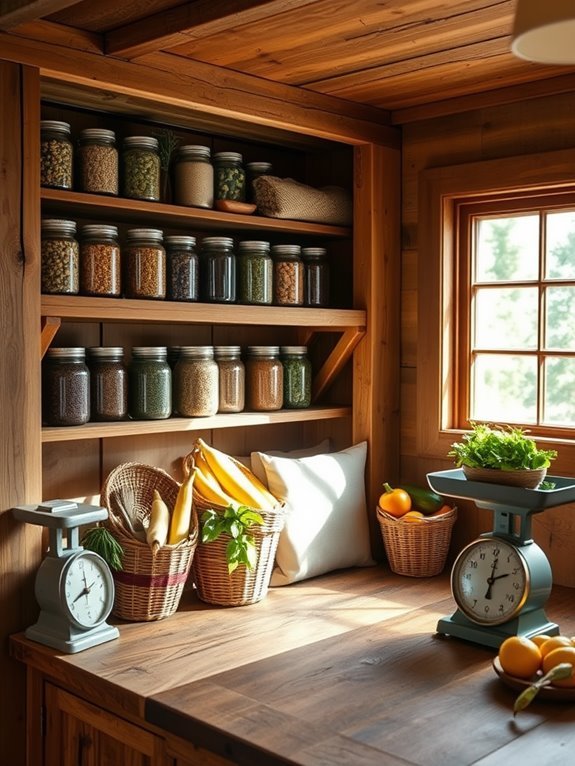
Living off the grid? A well-organized pantry is essential for making your cabin kitchen functional and inviting.
Think of it as your culinary treasure chest—each time you open it, you should feel inspired. Here’s how to set it up for a smile-inducing experience:
- Dried goods: Stock up on pasta, rice, and beans.
- Canned foods: Include soups, fruits, and veggies.
- Baking supplies: Keep flours, sugars, and spices handy.
- Snacks: Have nuts, granola bars, and dried fruits for energy.
- Homegrown produce: Store jars of pickles or sauces from your garden.
Label your shelves for a personal touch.
A well-stocked pantry not only reduces store trips but enhances the joy of cooking with available ingredients!
Prioritize Efficient Ventilation

Efficient ventilation is crucial in an off-grid cabin kitchen to maintain comfort and eliminate odors.
Install easily openable windows for fresh air, ideally positioned for cross-ventilation to create a breeze.
Add a range hood above the stove to improve airflow and capture smoke and steam.
A small ceiling fan can enhance air circulation and add charm.
Utilize passive ventilation like vents and louvers to regulate temperature.
With thoughtful planning, your kitchen will be both functional and inviting.
Enjoy cooking in your well-ventilated cabin kitchen!
Install a Greywater System

Installing a greywater system in your off-grid cabin conserves water and enhances sustainability by reusing sink or shower water for your garden.
Benefits of a greywater system include:
- Water Conservation: Recycle water instead of letting it go to waste.
- Plant Nourishment: Provide your garden with nutrient-rich water.
- Waste Reduction: Decrease water entering your septic system.
- Cost Savings: Lower water bills, freeing up money for cabin upgrades.
- Sustainable Living: Enjoy the satisfaction of a reduced environmental footprint.
Setting up is simple—connect your sink or laundry to a filtration system, and use biodegradable soaps to protect your plants.
Impress visitors with your eco-friendly setup, and inspire them to follow your sustainable lead.
Dive into greywater systems for the benefit of your cabin and the planet.
Use Non-Toxic Finishes

After installing a greywater system, enhance your cabin’s sustainability by using non-toxic finishes.
Avoid harmful chemicals that can contaminate air and water, and opt for natural oils, waxes, or water-based paints. These options are safer and can beautifully enhance your space.
Choose wood finishes labeled as low-VOC for eco-friendly benefits and improved health, while adding a warm glow to your kitchen.
For countertops, consider bamboo or reclaimed wood with a natural sealant, which are durable and environmentally friendly. This choice also protects kids and pets from toxic fumes.
Create a Rustic Aesthetic

To create a rustic aesthetic in your off-grid cabin kitchen, use natural materials and a warm color palette inspired by the landscape. Incorporate wooden beams, stone countertops, and earthy tones to bring nature indoors, making the kitchen a cozy and inviting space for gatherings or quiet moments.
Here are some ideas to get started:
- Reclaimed wood: Use for cabinets or shelves to add character.
- Vintage accents: Include quirky second-hand finds like old scales or mason jars for charm.
- Natural textiles: Opt for linen or cotton curtains and tablecloths for softness.
- Open shelving: Display dishware and pantry items for a lived-in look.
- Mood lighting: Use warm bulbs or rustic fixtures for a cozy glow.
Frequently Asked Questions
How Do I Choose the Best Location for My Off-Grid Cabin Kitchen?
When choosing the best location for your kitchen, consider sunlight, wind protection, and accessibility. You’ll want to guarantee it’s convenient for gathering supplies while maximizing natural light and minimizing energy needs for cooking.
What Are the Costs Associated With Building an Off-Grid Kitchen?
Building an off-grid kitchen can be surprisingly costly. You’ll need to factor in materials, appliances, and plumbing. It’s worth budgeting carefully, so you’re not caught off guard when expenses start adding up quickly.
How Can I Keep My Off-Grid Kitchen Organized and Clutter-Free?
To keep your kitchen organized and clutter-free, use vertical storage solutions, categorize items, and regularly declutter. Designate specific spots for utensils and ingredients, so everything has a place, making cooking more enjoyable and efficient.
What Types of Cooking Utensils Are Best for Off-Grid Living?
For off-grid living, you’ll want durable, multi-functional utensils. Opt for stainless steel or cast iron for cooking, bamboo or silicone for serving, and invest in a good knife. They’ll withstand wear and simplify your cooking experience.
How Do I Maintain My Off-Grid Kitchen Appliances?
Keeping your off-grid kitchen appliances running smoothly is like tending a garden; regular care nurtures their longevity. Clean them often, check connections, and replace worn parts to guarantee they serve you well for years.
Conclusion
Transform your off-grid cabin kitchen into a sustainable oasis by using natural materials and energy-efficient appliances. With creativity and eco-friendly charm, your kitchen becomes a delightful haven where every meal celebrates sustainable living.


